JWST captures galaxy from 11 billion years ago
Even more breathtaking images of space are being sent back by the James Webb Space Telescope, and this time, they are from the distant past. Images from the brand-new spacecraft show faraway galaxies with structures resembling those of the Milky Way, our galaxy.
The James Webb photos were taken when the galaxy was barely 25% of its present age and show a spiral galaxy with stellar bars, which are elongated structures of stars stretching out from the centre to the outer discs of galaxies around 11 billion years ago.
“I took one look at these data, and I said, ‘We are dropping everything else!’” described Shardha Jogee, a professor of astronomy at The University of Texas at Austin, in a media release.
“The bars hardly visible in Hubble data just popped out in the JWST image, showing the tremendous power of JWST to see the underlying structure in galaxies.”
Our understanding of how spiral galaxies form and evolve may change as a result of learning more about these galaxies and why they resemble the Milky Way galaxy.
The Hubble telescope has previously captured images of distant galaxies, but the obscuring dust and glare of young stars only revealed a hazy disk-shaped smudge. James Webb’s re-capture of these photographs revealed more information than before.
James Webb’s huge mirror makes it more effective at gathering light. The larger infrared wavelengths enable it to see through the dust with greater precision, and they also aid in identifying the underlying structure.
“For this study, we are looking at a new regime where no one had used this kind of data or done this kind of quantitative analysis before,” Study Finds quoted Yuchen “Kay” Guo, a graduate student who led the data analysis, as saying.
“So everything is new. It’s like going into a forest that nobody has ever gone into.”
A galaxy with the designation EGS-23205 seems to be a spiral galaxy with a distinct star bar. Another barred galaxy, EGS-2468, may have formed as long as 11 billion years ago, according to astronomers. Four further barred galaxies with ages of more than eight million years were discovered by the telescope.
Galaxy bars are crucial to a galaxy’s evolution because they direct gas into its core. In turn, the gas encourages the development of stars.
“Bars solve the supply chain problem in galaxies,” explained Jogee.
A bar moves gas into the galaxy’s centre at a rate that is typically 10 to 100 times quicker than in the rest of the galaxy, just as we must carry raw materials from the harbour to inland factories that create new products.
By guiding gas, bars can also aid in the formation of supermassive black holes in the galactic core.
Spiral bars appear to be a mechanism to speed up the creation of new stars during early epochs, which challenges astronomers’ beliefs on the formation of galaxies. These early bars also contradict the cosmos as it is currently understood because they add another variable to galactic physics.
As per a report by StudyFinds, the research study is accepted and will soon be published in The Astrophysical Journal Letters.


